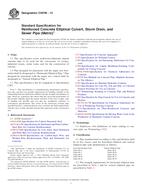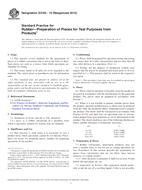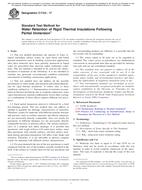1.1 This guide is applicable to crosscut, sweep-arm, and auger sampling systems.
1.1.1 Crosscut and Sweep-Arm Samplers -A crosscut sampler collects an increment as the sampler traverses a freely falling stream of coal, such as coal freely falling in a chute or freely falling from the head pulley of a conveyor. A sweep-arm sampler collects an increment as the sampler traverses a bed of coal on a moving conveyor belt. Both crosscut and sweep-arm sampling are designated Condition B (Full-Stream Cut) as defined in Section 6, Increment Collection Classification, of Test Methods D2234.
1.1.2 Auger Samplers -An auger sampler collects an increment of coal as the auger is inserted vertically into a stationary load of coal contained within a railcar, truck, or barge. Auger sampling is designated Condition D (Stationary Coal Sampling) as defined in Section 6, Increment Collection Classification, of Test Methods D2234.
1.2 Spacing of increments pertains to the kind of interval between increments. Intervals can be defined in quantitative terms, such as units of time or mass, or in terms of position over the lot.
1.2.1 Spacing of Increments for Crosscut and Sweep-Arm Samplers -Crosscut- and sweep-arm type mechanical sampling systems take increments based on time, either at fixed time intervals or at random times during a fixed time strata. Some crosscut samplers can take increments based on equal mass of coal sampled as determined by scales. The sections of this guide that pertain to crosscut and sweep-arm samplers describe procedures for only time-based sampling systems. This time-based inspection guideline will satisfy most criteria for mass-based or combination mass-based and time-based sampling systems. If there are items that are not covered, the inspector should refer to the manufacturer’s literature.
1.2.2 Spacing of Increments for Auger Sampling -The spacing of increments collected by auger sampling systems is defined in terms of position over the lot.
1.3 It is essential that the inspector have the documentation listed in Section 2 of this guide when conducting an inspection.
1.4 The values stated in SI units are to be regarded as the standard. The values given in parentheses are for information only.
1.5 This standard does not purport to address all of the safety problems, if any, associated with its use. It is the responsibility of the user of this standard to establish appropriate safety and health practices and determine the applicability of regulatory limitations prior to use. For a specific hazard statement, see Section 5.
Product Details
- Published:
- 01/01/1997
- Number of Pages:
- 6
- File Size:
- 1 file , 73 KB


